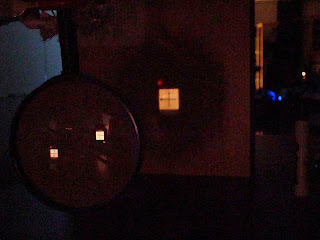To begin the experiment we connect each of the LEDs one at a time in series with a 680 ohm resistor to a power supply. We then use the equation (lambda)=(D*d)/[sqrt(L^2+D^2)] to calculate the wavelength of each of the LEDs. L was 1.29 +/- 0.005 meters and d was 1.67*10^-6 +/- 0.015 meters. The values for D of each of the different colored LEDs are given below. Each of the values have an uncertainty of +/-0.01
Red: 0.54 m
Yellow: 0.49 m
Green: 0.42 m
Blue: 0.38 m
The wavelengths were then calculated with corresponding uncertainties of +/-1.15*10^-8 meters.
Red: 644.9 nm
Yellow: 593.0 nm
Green: 517.0 nm
Blue: 471.9 nm
Next we measure the voltage across each of the LEDs.
Red: 1.86 ohms
Yellow: 1.90 ohms
Green: 2.50 ohms
Blue: 2.66 ohms
We then plotted voltage vs. 1/wavelength and received the following graph.
The slope of our equation is 1.573*10^-6 meters. Multiplying by q and dividing by the speed of light we get a value for Planck's constant to be 8.756E-34 J*s.The true value for Planks constant is 6.626*10^-34. This gives us a percent error of 32%. This percent difference is very high but not surprising considering the apparatus we used and the inaccuracies of the measurements. Remember, in the previous experiment we used a graph to account for any discrepancy in the wavelength to reduce the error; in this experiment we were unable to do that. To reduce the error we would have to make more accurate measurements, account for the small angle approximation, and make sure the our rulers were place exactly perpendicular. Also I would have been useful to know the true wavelengths that each of the LEDs gave off so that we could have something to compare our data too. In this experiment we were also able to see that the red LED consumed the least amount of energy while the blue LED used the most amount of energy. This matches what the equation E=hc/(lambda) tells us.


















